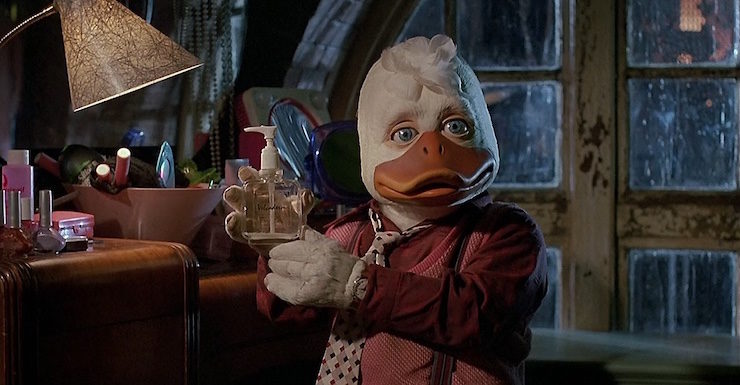The 1960s was the decade of the secret agent: James Bond, Our Man Flint, The Man from U.N.C.L.E., Danger Man, The Avengers (the British TV show, not the American super-team), and so on. Marvel decided to cash in on this trend by taking the star of their World War II comic Sgt. Fury and His Howling Commandos (which debuted in 1963), aging him 20 years and making him a colonel, and putting him in charge of the Supreme Headquarters of International Espionage, Law-enforcement Division, or S.H.I.E.L.D. for short. (It was later changed to Strategic Hazard Intervention Espionage Logistics Directorate.)
The 1970s was the decade of wackiness: mainstream comics took their superheroes into different places, from martial arts to horror to blaxploitation to just plain crazy. One of the particularly crazy ones came from Steve Gerber and Val Mayerik, who gave us the world’s most obnoxious funny-animal character in Howard the Duck, introduced in a Man-Thing story in a 1973 issue of Adventure into Fear.
Both characters developed cult followings, the former due in particular to the iconic, stylish artwork of Jim Steranko, the latter due to just being totally batshit. Both were made into live-action films that did not live up to their cult status even a little bit.
George Lucas was a big fan of the Howard the Duck character, and after production wrapped on American Graffiti, he approached his co-writers William Huyck and Gloria Katz about the possibility of adapting the character to film. Huyck and Katz wanted to do it as animation, while Lucas felt that his Industrial Light & Magic special effects house could make it effective in live-action. Huyck and Katz also toned down the more subversive elements of the comic books (as but one of many examples, one of Howard’s primary villains was the gleefully ludicrous Dr. Bong, who appears nowhere in the movie, a seriously missed opportunity). The movie was released in 1986, three years after Star Wars: Return of the Jedi, and when people believed that Lucasfilm Ltd. could do no wrong, a notion that this movie helped prove wrong.
Amazingly, Howard the Duck was the first Marvel Comics character to be adapted into a feature film that was shown in theatres. Marvel had had plenty of TV movies and TV series (many of which we’ve covered in this series) in the 1970s, but it took until ’86 for a theatrical release, and it was, of all things, a satirical character from the horror-comics world.
Meanwhile, in the 1990s, the FOX network had reserved Tuesday nights for movies. Sometimes they would provide the broadcast premiere of a theatrical film, but they also produced original TV movies, such as Gargantua (which your humble rewatcher actually novelized, under the pseudonym K. Robert Andreassi in early 1998), The O.J. Simpson Story, Tornado!, and Nick Fury, Agent of S.H.I.E.L.D.
Fury was reimagined for Marvel’s “Ultimate” line in 2000 as an African-American veteran of the Gulf War, done due to the ever-shifting timeline of mainstream comics that made his being a World War II vet less and less realistic. (The Ultimate character design was patterned after avowed comics fan Samuel L. Jackson, which is at least partly how they got him to play the part in the Marvel Cinematic Universe.) But prior to that, he was a cigar-chomping white guy, a gruff drill-sergeant type very much not in the mode of the more suave secret agents that were his contemporaries in the 1960s, which was part of how the character stood out. David Hasselhoff, best known for his starring roles in Knight Rider in the 1980s and Baywatch in the 1990s, threw on an eyepatch and starred in this reimagining of the comics. This was an early comics adaptation script by David S. Goyer, who has gone on to become one of the most prolific scripters of movies we’ll see in this rewatch (as well as similar TV shows), but whose only previous comics-adaptation credit at this point was The Crow: City of Angels, though his script for Blade was also produced in ’98.
“Different lifestyles is one thing, different life-forms is another!”
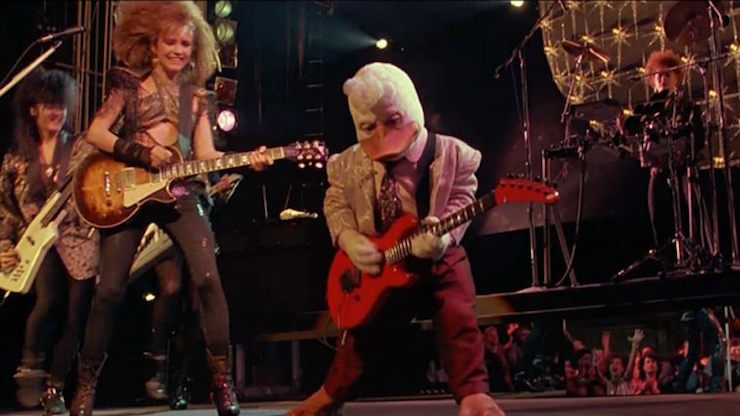
Howard the Duck
Written by Willard Huyck & Gloria Katz
Directed by Willard Huyck
Produced by Gloria Katz
Original release date: August 1, 1986
Howard lives on a world where ducks are sentient, ambulatory, and mammals (based on one woman we see taking a bath). One day, he gets home from work, checks his mail and answering machine, watches TV, and suddenly finds himself sucked through the air and into a dimensional vortex, winding up on our world, specifically in Cleveland.
Everyone is, to say the least, confused by the walking, talking duck dressed in a suit. After he gets manhandled by punks and screamed at by a couple making out in an alley, he takes refuge in an empty garbage can. His reverie is interrupted by Beverly, the lead singer in a band, who is menaced by two punks. Howard and Beverly take care of them, and in gratitude (and confusion), Beverly offers to let him crash at her run-down place. Since it’s raining, Howard takes her up on it.
He reveals that he went to med school, but dropped out, and now works as an advertising copy-writer, having failed in his ambition to be a songwriter. Beverly can sympathize, as a songwriter herself. After Howard falls asleep, his wallet falls out of his pocket. Beverly goes through it and sees anatidaean versions of everything, from credit cards to currency, not to mention his driver’s license.
The next day, she takes him to see a friend of hers, Phil Blumburtt, who works at the Natural History Museum. Phil, however, is a complete putz, and also isn’t a scientist, but rather a lab assistant. Howard is fed up with humanity entirely, and he and Beverly argue and part ways.
Howard attempts to find employment, but the only job he can get is as maintenance duck/towel boy at a massage parlor/whorehouse/mud wrestling emporium, which he quits after one day. He wanders the streets of Cleveland, eventually finding his way back to the alley where he landed and the club where Beverly’s band, Cherry Bomb, plays. Impressed with their music, he confronts Ginger, their manager, who is holding back their pay until Beverly puts out. Howard starts a bar fight that ends very badly for Ginger and he agrees to stop being their manager and give them all their money.
Howard makes up with Beverly, gives the band their money, and then he goes back home with Beverly. They almost sorta kinda move toward the possibility of having sex, kind of, except Beverly backtracks and says she was kidding. Phil then arrives with a scientist friend of his and his boss, Dr. Jenning, who works at Dynatechnics, which recently did an experiment to shoot a laser into space. The laser malfunctioned and struck Howard’s planet, bringing him here. Howard really wants to go home, as Beverly is the only person he likes on Earth, and Jenning agrees to send him back.
Unfortunately, when they arrive at Dynatechnics, the laser malfunctions even more and explodes. The cops are called to deal with the damage; also Jenning is missing. The cops try to arrest Howard, but he and Beverly manage to escape. They find Jenning, who declares that a dark force has taken over his body. They don’t believe him, and once they slip away from Dynatechnics in Jenning’s car, they head to a diner. Jenning’s crazy talk and Howard’s very existence is confusing to the staff of Joe Roma’s Cajun Sushi. The denizens turn into a mob that goes after Howard, but then Jenning’s body is completely taken over by a Dark Lord of the Universe that came in on the laser and inhabited the scientist’s form. The Dark Lord all but destroys the diner, scaring away the customers, and then he takes Beverly hostage and—after stopping off at a nuclear power plant to absorb its energy to power itself—returns to Dynatechnics.
With help from Phil—who was arrested for trespassing on Dynatechnics—Howard steals an ultralight and he and Phil sort-of-almost-kind-of fly to Dynatechnics. Howard does pause along the way to buzz some duck hunters. The cops don’t catch up to them, even though an ultralight can’t go more than about 60 MPH. Upon arrival at Dynatechnics, Phil takes Howard to an untested, experimental neutron blaster, which they use to blast the Dark Lord. The creature abandons Jenning’s body, and Howard is eventually able to destroy the creature with the blaster. He also, reluctantly, destroys the laser before it can bring three more Dark Lords to Earth, thus cutting him off from home.
He decides to become Cherry Bomb’s manager, with Phil now as their roadie.
“That’s the problem with the Third Reich—no sense of humor”
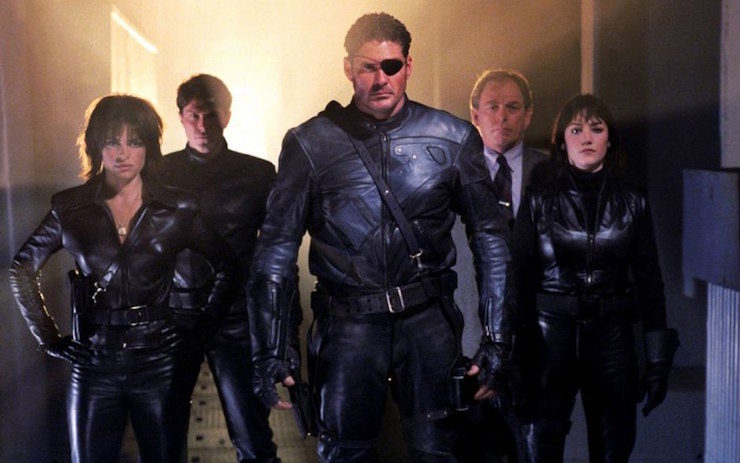
Nick Fury, Agent of S.H.I.E.L.D.
Written by David S. Goyer
Directed by Rod Hardy
Produced by Avi Arad
Original release date: May 26, 1998
The body of Baron Wolfgang von Strucker, the leader of the terrorist organization Hydra, is being held in stasis on a secret S.H.I.E.L.D. base. The forces of Hydra, united under von Strucker’s daughter Andrea and son Werner, liberate von Strucker’s body, the cells of which still contains the Death’s Head Virus. S.H.I.E.L.D. Agent Clay Quartermain is killed in the attack by Andrea, who goes by the nickname “Viper.”
After he killed von Strucker five years previous, Colonel Nick Fury was relieved of his post as the head of S.H.I.E.L.D. However, with the theft of von Strucker’s body and the possibility that Hydra might release the Death’s Head, two agents travel to the Yukon to retrieve and reactivate Fury: Contessa Valentina Allegra de Fontaine (Fury’s ex) and new agent Alexander Goodwin Pierce. Fury is only willing to take his old job back after he finds out a) about von Strucker’s body and b) about Quartermain’s death.
Director General Jack Pincer is not pleased to see Fury, but his colleagues Timothy Dugan and Gabriel Jones are thrilled to have him back. The scientist who created the Death’s Head, Arnim Zola, is in a S.H.I.E.L.D. safehouse in Berlin. Fury, Fontaine, and Kate Neville (who is psychic) travel there to interrogate Zola about the virus. They’re met by an Interpol agent, Gail Runciter, who turns out to be Viper in disguise. She distracts Fury and frees Zola, poisoning Fury with the Death’s Head along the way.
Viper uses a Life-Model Decoy of Pincer to let S.H.I.E.L.D. know that she plans to detonate a missile filled with the virus in New York City unless she is paid a billion dollars. Fury—who refuses to spend his last hours in the Helicarrier sickbay—believes that she’ll kill everyone in New York either way. Fontaine takes a team to Manhattan to try to find the missiles while Fury, Neville, and Pierce do a surgical strike on Hydra’s headquarters. (Fury disobeys Pincer’s orders and Jones’s medical advice to go on the mission, and Neville and Pierce put their careers in jeopardy to help a guy they’ve only just met disobey orders for no obvious reason.) Initially, the S.H.I.E.L.D. agents are captured by Viper, but they manage to break out of their cell thanks to the one gadget Hydra didn’t take off them: the bomb secreted in Fury’s empty left eye socket.
Fontaine’s team finds Werner with the missiles, and Fontaine is able to shoot him in the head before he can launch them. But it turns out that Viper never intended to let Werner fire the missiles—or live. Fontaine needs the shutdown code.
Fury sends his Life-Model Decoy in to fight Viper. Zola grabs Fury’s weapon, which can only be fired by him. When Zola tries to use it, the weapon electrocutes the elderly scientist. After Viper “kills” the LMD, the real Fury manages to subdue her, and then he gets Neville to read her psychically to get the shutdown code.
While the code works, and the Helicarrier arrives soon thereafter to shut Hydra down once and for all, Viper manages to escape with her father’s body. They relocate to a redoubt where von Strucker is resurrected and they plan to restart Hydra again.
Pincer is pissed that Fury disobeyed his orders, and he plans to convene a tribunal. After he lists the charges, Fury says he forgot the charge of assault of a superior officer, and then Fury belts him. Then he and Fontaine look at the nice view from the Helicarrier.
“You don’t make me proud to be a human!”
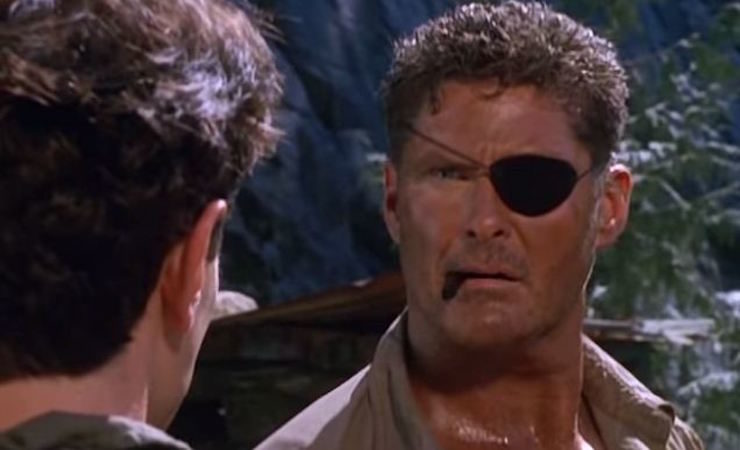
Both the subjects of these two movies were very much products of their time. Howard the Duck was created in the very cynical and bitter 1970s, an era when the guarded optimism and tumult of the 1960s gave way to the disastrous end to the Vietnam War, fiscal crises, oil crises, hostage crises, and the first time in the country’s two-hundred-year history that the president and vice president both resigned in disgrace. Howard came out of that time: obnoxious, cynical, bitter, sleazy, cigar-smoking, lewd, crude, and slimy. Meanwhile, Nick Fury was a curious mix of two popular 1960s archetypes: the gruff World War II soldier and the secret agent fighting a high-tech war against the bad guys.
Neither of those were good fits for the eras in which their live-action movies were made. Howard the Duck was made in the 1980s, a decade that ran as far away from the 1960s and 1970s as possible. That era was all about bright primary colors, big hair, optimism, and “morning in America.” Nick Fury, Agent of S.H.I.E.L.D. was made in 1998, which was one of the worst times to do a spy thriller, as the genre was at its low ebb in the era between the fall of the Berlin Wall and the fall of the Twin Towers.
So I went into these movies with low expectations.
Those expectations were greatly exceeded. These may be the two worst movies I’ve seen in this rewatch so far, and given that I’ve reviewed Son of the Mask and The Crow: Wicked Prayer, I do not say this lightly.
One doesn’t have high expectations for any movie starring David Hasselhoff, truly—yes, he was a TV star twice over, but people watched Knight Rider for the car and Baywatch for the scantily clad bodies, not the meager thespic skills of their lead. But watching this movie, I was amazed that anybody ever hired David Goyer to write anything ever again. To be fair, there’s nothing else on his resumé quite as bad as this—he’s scripted or co-scripted plenty of dreadful movies, but nothing with dialogue as wretched as the nonsensical idiocy of this movie, and he’s also got some fine scripts under his belt.
And while the best writing can elevate an actor’s ability (there are tons of actors whose best work has come when Aaron Sorkin writes their dialogue, as an example), Goyer’s not that good, and most of these actors are also really that bad. Hasselhoff we all know about, but at least he brings a certain rugged charm to the proceedings, and also he looks and acts pretty much exactly like the Fury of the comics. But there’s nothing else here to grab onto. Garry Chalk and Ron Canada are completely serviceable as Dugan and Jones, at least, but both characters have been blandified so much as to be unrecognizable. Tom McBeath is awful as the tiresomely slimy Pincer (McBeath would do much better with a similar type of character, albeit one way more nuanced, when he played Maybourne on Stargate SG-1), Neil Roberts and Tracy Waterhouse are dull as dishwater as Pierce and Neville, Peter Haworth brings absolutely no menace to Zola, and Lisa Rinna manages to make Fontaine supremely boring (not helped by a script that keeps the Fury’s-girlfriend angle of the comics character, but excises all the rest of it, changing her from an elegant Italian ingenue to an ordinary agent with a 90s pixie cut).
But the worst are the dreadful, embarrassing performances by Scott Heindl as Werner, and especially Sandra Hess as Viper. These two are so over the top their ears are popping, and they’re basically impossible to take seriously as bad guys.
What’s frustrating is that the basic story of Nick Fury is perfectly fine. It’s a straightforward S.H.I.E.L.D.-versus-Hydra tale that I could easily see Jim Steranko writing and drawing in 1968. But the script is so hideously clunky, the acting so frighteningly awful, that you just sit there and wonder who they expected to like this film.
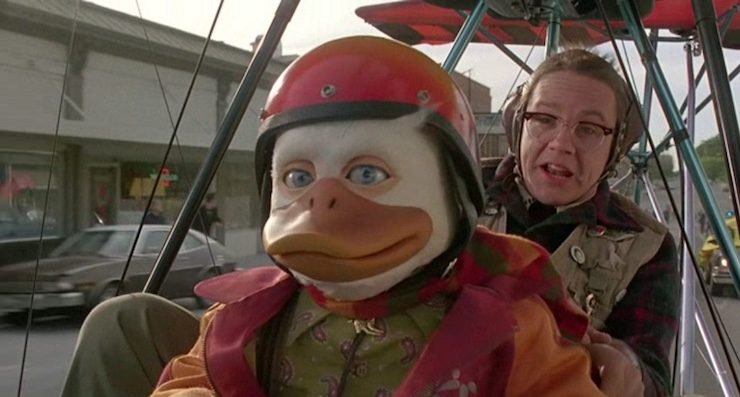
And you know what? If I had to choose between that and Howard the Duck, I’d choose Nick Fury every day of the week and twice on Sunday, because the only thing watching Howard is good for is to destroy your soul and remove your ability to feel joy and happiness.
One of the worst movies I’ve ever seen is Mac and Me, a cynical attempt to cash in on E.T. that was actually made two years after Howard, but all three movies have basically the same plot: strange creature comes to Earth and tries to go home, but befriends a couple of people and has adventures. Both Howard and Mac and Me have musical numbers inserted, though Howard’s are, at least, more organic, as Beverly is in a band, and its Cherry Bomb’s songs we get. And where E.T. had a bike ride, and Mac and Me would later have a wheelchair chase (really!), Howard gives us the absurd ultralight chase.
If one isn’t familiar with Howard’s comics origins, one could possibly see one’s way to liking this movie. Lea Thompson is engaging as Beverly, at least, and Jeffrey Jones is a delight as the Dark Lord of the Universe. But they’re the only actual good performances.
If you know the original comics, though, and especially if you like them, you’ll want to throw a shoe at the screen. None of Howard’s cynicism or sleaze is present. He barely smokes his cigar, his obnoxiousness has been toned down significantly, and the character design is way too cutesy for his cynicism to come across as anything other than an act. Beverly’s origins have also been toned down (when he met her in the comics, she was an artist’s nude model), and the Howard of the comics would never have objected to working in a massage parlor. There’s no satire in this movie, no bite, no sense of fun. In the comics, Howard faced off against Dr. Bong, Pro-Rata the Cosmic Accountant, Turnip-Man, Kidney Lady, Garko the Man-Frog, and the Winky Man. He went on road trips and ran for president. It was delightful lunacy, and this movie doesn’t even have a trace of it. Instead, they just do a movie that reminds me of Mac and Me, which is a horrible thing to do to anyone, and probably violates the Geneva Convention.
On top of all that, it’s horrendously paced. Supposedly the movie is only an hour and fifty minutes long, but I’m fairly certain it took me about seven months to get through it. I mean, we reached what I thought was the climax, and there was still half an hour left, and I was about ready to gnaw my leg off at the knee.
It’s really too bad that this movie was so horrible, because Howard is a great character who has been unfairly maligned by association with this movie. (The character has also been the subject of two different lawsuits, one by Gerber against Marvel, one by Disney against Marvel—yes, that’s weird to write now—because the Mouse thought the character was too similar to Donald Duck. Marvel won both suits, though Gerber managed to “reclaim” his character through a secret crossover in 1996 between Spider-Man Team-Up #5 and The Savage Dragon/Destroyer Duck #1.) The only post-credits scene in the Marvel Cinematic Universe that failed was the one at the end of Guardians of the Galaxy, because either people had no idea who that talking duck was, or they thought it was that guy from what was the nadir of Lucasfilm’s oeuvre prior to 1999.
Maybe they’ll make it work eventually.
Anyhow, next week we go from the ridiculous to the sublime, as we get two adaptations that never actually made it to theatres, with good reason, 1990’s Captain America and 1994’s Fantastic Four.
Keith R.A. DeCandido is trapped in a world he never made.










